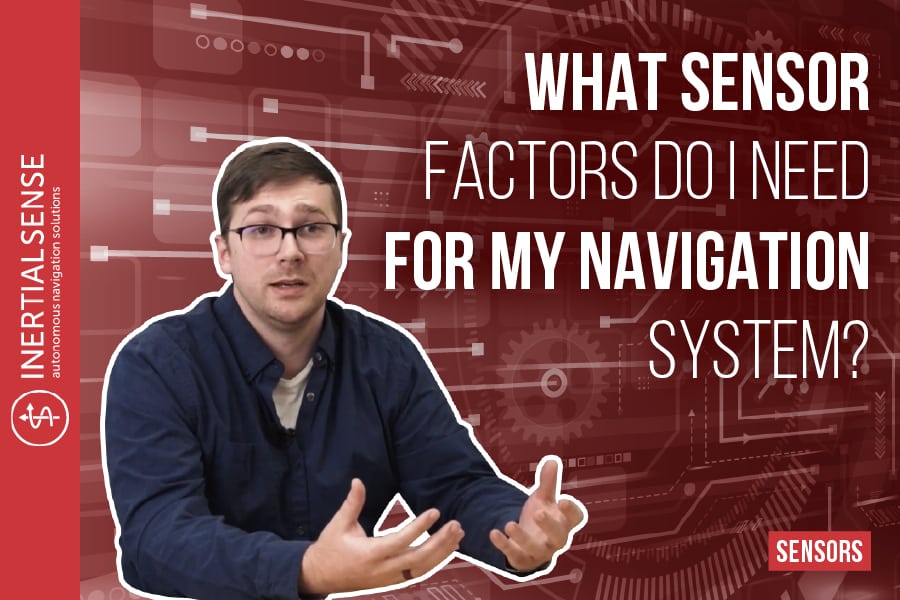
What Sensor Factors Do I Need for My Navigation System?
Are you looking to optimize your robotics build but are curious about which sensor factors you need and how to get the best sensor performance? Watch the video below as Morgan Rudolph, Head of Operations at Inertial Sense, explains what to look for when building your new navigation system. In this video installment, “What Sensor Factors Do I Need for My Navigation System?” we’ll unpack a few important questions you need to ask yourself when considering your navigation system’s design, capabilities and overall sensor performance.
Be sure to check out the video transcript below for a practical breakdown of each critical question you must ask yourself and consider during this phase of the build. We’ll be publishing more helpful videos from some of our top engineers and leadership team members so be sure to like and subscribe to our YouTube channel so you don’t a beat!
Video Transcription:
What Sensor Factors Do I Need?
Consider your cost, application, environment and interface.
When you’re looking to find a new navigation system, you’re going to think about your cost, your application, specifically are you flying or are you in a marine aquatic-type of environment or are you a ground robot.
You’re going to also want to think about what type of interface you’re looking at. Are you going to be using serial RS-232 or some other application.
When you’re trying to price sensors, it’s important to think about the type of accuracy that you’re going to need for your system. Will just GPS do, or will you actually need high attitude performance as well as heading? And there’s a wide variety of navigation sensors out there that can give you the sensor performance you need. But you need to understand what you’re going for as you go to research.
What level of accuracy do you need?
Inertial Sense has sensors that range from 2 cm to 3m of accuracy depending on your needs. What level of accuracy do you need for your navigation system?
Sensor Performance
How to find the right performance specifications for your device’s needs.
So the performance issue for whatever application you’re looking for, it’s very particular to the needs.
Did You Know? Inertial Sense offers sensors with 0.1 degree accuracy and optional 1.8 degree/hr Bias Stability
For example, a ground robot is going to need far less performance than say a flying helicopter or plane (where they need three degrees of freedom, where a robot you just care about is translating on the ground).
Other Outside Factors:
Can it integrate easily into your system (via USB or a more complicated system like TTL or RS232)?
Other outside factors you can look into is how easy it is to actually integrate into your system. If you’re looking for something that you can plug in via USB, or whether you’re interested in doing a more complicated communication system like with TTL or with RS-232, those are probably the other big factors to bringing in another system.
Why is the protocol interface important when finding the right sensor?
It’s important to consider the interface because if your system is using TTL and the sensor you’re interested in incorporating doesn’t have TTL as an available interface, it’s going to add development time to try to integrate that into a system that doesn’t support it.
The development time for potential developers or research groups is really important because that’s actually the significant part of bringing a new product to market. You’re going to spend much more time trying to figure out how to paste all of these parts together than you are actually going to be shopping. And if you can shorten that development time, that means that you need far less to actually get started.
Did You Know? Inertial Sense’s support team are local engineers who work with the product every day and know it inside and out, helping you shorten development time.
Sensor Performance – Avoiding the performance pitfall problems
So, when research and development groups go to create a product, what they’ll typically want to do is grab a sensor more than adequate. They don’t want to just get it (the sensor capabilities) just barely to the performance level that they need. They’re going to go a little bit further above, and the reason for that is that they, in case there was a little bit of oversight in their development process, the engineers can actually compensate for that at a hardware level.
And then once the engineers and developers have a proof of concept, a working product, they can then work on getting the cost down through different programming. Maybe a couple of hardware swaps but that’s typically how that design and research process works. Yeah, so, they’re going to typically go for that higher-level sensor just because it will save on that development time. The engineers will just be able to plug it in without having to really work on that interface, which is just going to save a lot of time and money, and in the end time is money so.
Learn More:
How to chose the right inertial sensor for your build
The World’s Smallest “Better than GPS” Inertial Navigation System Now Available

